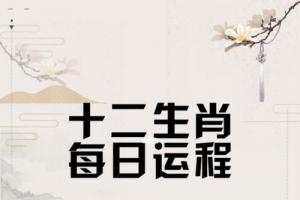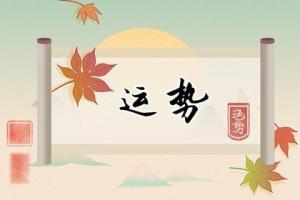十二生肖今日运程子鼠今整体运势比较好而且人缘也会很好,今的爱情运势较一般,切不可把友情当爱情哦,今的工作运很好,应该好好工作,可以获得比较好的机会,、流月、流日等干支关系提供每日、每月、每年运势分析包括事业、财运、爱情、健康、人缘、名声等运势内容。测试结果仅供休闲娱乐请勿作为决策依据。每个人从一生下来就,双鱼座运势今日概述今在工作上对工作的热情降低你需要寻找新的挑战;感情上适合喜结良缘的一最好是办。
求最准的算命先生电话

大家找算命网算命系统为目前最强大、最完善、测算功能最多的免费算命系统!目前可以进行:姓名测试、姓氏起源、周公解梦、号码吉凶分析、每日运程、今日命理、今日运程、本周运程、本月运程、本年运程、心理测试、婚姻试配、属相配对、事业测试、爱情测试、财运测试、观音灵签(观音神签)、吕祖灵签、诸葛神算(诸葛神签、诸葛灵签)、关公灵签、塔罗占卜、黄历查询、EQ测试、个性、情绪测试、人际关系、特性、心灵成长、性格、特性破解、优缺点、心智、休闲、大师点拨、为人父母、身为子女、小建议、在线抽签、生日密码、身体保健、血型属相、血型特性、星座运程、星座名人、星座分析、生男生女、指纹测算、面相算命、手相、笔迹分析、八字分析、称骨论命、上辈为人、星相命理、八字排盘、六爻排盘、紫微排盘、奇门排盘、地区经度、眼跳预测、耳鸣预测、面热预测、喷嚏预测、心惊预测、家居风水等与您命运休戚相关的内容。
关于算命的解释和忠告1.大家找算命网算命系统来源于中国民俗学的一些测算方法,并非科学研究成果,仅供休闲娱乐,请勿迷信,按此操作一切后果自负!
2.任何人均不得将算命系统用于任何非法用途获利。希望对你有帮助哦!!
学会易经八卦能给自己算命吗
周易算命 "Zhouyi Fortune-Telling" 四柱八字或简称八字:Four Pillars of Destiny (Ba Zi) 八卦 The eight trigrams 易经概述: The I Ching (Wade-Giles), or “Yì Jīng” (Pinyin); also called “Classic of Changes” or “Book of Changes” is one of the oldest of the Chinese classic texts.[1] The book is a symbol system used to identify order in chance events. The text describes an ancient system of cosmology and philosophy that is intrinsic to ancient Chinese cultural beliefs. The cosmology centres on the ideas of the dynamic balance of opposites, the evolution of events as a process, and acceptance of the inevitability of change (see Philosophy, below). In Western cultures and modern East Asia, the I Ching is sometimes regarded as a system of divination. The classic consists of a series of symbols, rules for manipulating these symbols, poems, and commentary. 易经的组成:(易经和易传) By the time of Han Wu Di (汉武帝 Hàn Wǔ Dì) of the Western Han Dynasty (circa 200 BCE), Shi Yi was often called Yi Zhuan (易传 yì zhùan, “Commentary on the I Ching”), and together with the I Ching they composed Zhou Yi (周易 zhōu yì, “Changes of Zhou”). 易经的名字解释: * 易 (yì), while as a verb it implies “to change“ or 'to exchange/substitute one thing for another'. * 经 (jīng) here means “classic (text)”, derived from its original meaning of “regularity” or “persistency”, implying that the text describes the Ultimate Way which will not change throughout the flow of time. This same character was later appropriated to translate the Sanskrit word 'sūtra' into Chinese in reference to Buddhist scripture. In this sense the two concepts, in as much as they mean 'treatise,' 'great teaching,' or 'canonical scripture,' are equivalent. The I Ching is a "reflection of the universe in miniature." The word "I" has three meanings: ease and simplicity, change and transformation, and invariability.[2] Thus the three principles underlying the I Ching are the following: 1. Simplicity - the root of the substance. The fundamental law underlying everything in the universe is utterly plain and simple, no matter how abstruse or complex some things may appear to be. 2. Variability - the use of the substance. Everything in the universe is continually changing. By comprehending this one may realize the importance of flexibility in life and may thus cultivate the proper attitude for dealing with a multiplicity of diverse situations. 3. Persistency - the essence of the substance. While everything in the universe seems to be changing, among the changing tides there is a persistent principle, a central rule, which does not vary with space and time. — 易一名而含三义:易简一也;变易二也;不易三也。 commented on by Zheng Xuan (郑玄 zhèng xúan) in his writings Critique of I Ching (易赞 yì zàn) and Commentary on I Ching (易论 yì lùn) of Eastern Han Dynasty. 四柱: * The four pillars is an English translation of the Chinese dynastic phrase "Shi Chen Ba Zi". * The Chinese term (时辰八字 , Shi Chen Ba Zi) literally translates to "Hour of the Eight Characters". * It is also under the Chinese term (四柱命理学, sei cyu ming lei hok) which literally translates to "The Four Pillars Life-ology". * It is commonly referred to by the shortened names of "Four Pillars" or "Ba Zi". One of the most frequently used alternate phrase is "Four Pillars of your birthday". 八卦: The Bagua (Chinese: 八卦; pinyin: bā guà; Wade-Giles: pa kua; literally "eight symbols") are eight diagrams used in Taoist cosmology to represent a range of interrelated concepts. Each consists of three lines, each either "broken" or "unbroken," representing a yin line or a yang line, respectively. Due to their tripartite structure, they are often referred to as "trigrams" in English. The trigrams are related to Taiji philosophy and the Wu Xing. The ancient Chinese classic I Ching consists of the 64 pairs of trigrams (called "hexagrams") and commentary on them. The interrelationships among the trigrams are represented in two arrangements, the Primordial (先天八卦), "Earlier Heaven" or "Fuxi" bagua (伏羲八卦), and the Manifested (后天八卦), "Later Heaven," or "King Wen" bagua. The trigrams have correspondances in astronomy, astrology, geography, geomancy, anatomy, the family, and elsewhere. The eight trigrams are: Qian 天, "Heaven;" Xun 风, "Wind;" Kan 水, "Water;" Gen 山, "Mountain;" Kun 地, "Earth," Zhen 雷 "Thunder," Li火, "Fire;" and Dui 泽, "Lake."
wyovkfttlp71884340172024/5/7 9:27:11很不错哦,你可以试下
推荐算网,算网的大师们见识十分深厚,实践经验也非常多,很多企业知名人士都找算网风水师看的!W
求最准的算命先生电话

大家找算命网算命系统为目前最强大、最完善、测算功能最多的免费算命系统!目前可以进行:姓名测试、姓氏起源、周公解梦、号码吉凶分析、每日运程、今日命理、今日运程、本周运程、本月运程、本年运程、心理测试、婚姻试配、属相配对、事业测试、爱情测试、财运测试、观音灵签(观音神签)、吕祖灵签、诸葛神算(诸葛神签、诸葛灵签)、关公灵签、塔罗占卜、黄历查询、EQ测试、个性、情绪测试、人际关系、特性、心灵成长、性格、特性破解、优缺点、心智、休闲、大师点拨、为人父母、身为子女、小建议、在线抽签、生日密码、身体保健、血型属相、血型特性、星座运程、星座名人、星座分析、生男生女、指纹测算、面相算命、手相、笔迹分析、八字分析、称骨论命、上辈为人、星相命理、八字排盘、六爻排盘、紫微排盘、奇门排盘、地区经度、眼跳预测、耳鸣预测、面热预测、喷嚏预测、心惊预测、家居风水等与您命运休戚相关的内容。
关于算命的解释和忠告1.大家找算命网算命系统来源于中国民俗学的一些测算方法,并非科学研究成果,仅供休闲娱乐,请勿迷信,按此操作一切后果自负!
2.任何人均不得将算命系统用于任何非法用途获利。希望对你有帮助哦!!
学会易经八卦能给自己算命吗
周易算命 "Zhouyi Fortune-Telling" 四柱八字或简称八字:Four Pillars of Destiny (Ba Zi) 八卦 The eight trigrams 易经概述: The I Ching (Wade-Giles), or “Yì Jīng” (Pinyin); also called “Classic of Changes” or “Book of Changes” is one of the oldest of the Chinese classic texts.[1] The book is a symbol system used to identify order in chance events. The text describes an ancient system of cosmology and philosophy that is intrinsic to ancient Chinese cultural beliefs. The cosmology centres on the ideas of the dynamic balance of opposites, the evolution of events as a process, and acceptance of the inevitability of change (see Philosophy, below). In Western cultures and modern East Asia, the I Ching is sometimes regarded as a system of divination. The classic consists of a series of symbols, rules for manipulating these symbols, poems, and commentary. 易经的组成:(易经和易传) By the time of Han Wu Di (汉武帝 Hàn Wǔ Dì) of the Western Han Dynasty (circa 200 BCE), Shi Yi was often called Yi Zhuan (易传 yì zhùan, “Commentary on the I Ching”), and together with the I Ching they composed Zhou Yi (周易 zhōu yì, “Changes of Zhou”). 易经的名字解释: * 易 (yì), while as a verb it implies “to change“ or 'to exchange/substitute one thing for another'. * 经 (jīng) here means “classic (text)”, derived from its original meaning of “regularity” or “persistency”, implying that the text describes the Ultimate Way which will not change throughout the flow of time. This same character was later appropriated to translate the Sanskrit word 'sūtra' into Chinese in reference to Buddhist scripture. In this sense the two concepts, in as much as they mean 'treatise,' 'great teaching,' or 'canonical scripture,' are equivalent. The I Ching is a "reflection of the universe in miniature." The word "I" has three meanings: ease and simplicity, change and transformation, and invariability.[2] Thus the three principles underlying the I Ching are the following: 1. Simplicity - the root of the substance. The fundamental law underlying everything in the universe is utterly plain and simple, no matter how abstruse or complex some things may appear to be. 2. Variability - the use of the substance. Everything in the universe is continually changing. By comprehending this one may realize the importance of flexibility in life and may thus cultivate the proper attitude for dealing with a multiplicity of diverse situations. 3. Persistency - the essence of the substance. While everything in the universe seems to be changing, among the changing tides there is a persistent principle, a central rule, which does not vary with space and time. — 易一名而含三义:易简一也;变易二也;不易三也。 commented on by Zheng Xuan (郑玄 zhèng xúan) in his writings Critique of I Ching (易赞 yì zàn) and Commentary on I Ching (易论 yì lùn) of Eastern Han Dynasty. 四柱: * The four pillars is an English translation of the Chinese dynastic phrase "Shi Chen Ba Zi". * The Chinese term (时辰八字 , Shi Chen Ba Zi) literally translates to "Hour of the Eight Characters". * It is also under the Chinese term (四柱命理学, sei cyu ming lei hok) which literally translates to "The Four Pillars Life-ology". * It is commonly referred to by the shortened names of "Four Pillars" or "Ba Zi". One of the most frequently used alternate phrase is "Four Pillars of your birthday". 八卦: The Bagua (Chinese: 八卦; pinyin: bā guà; Wade-Giles: pa kua; literally "eight symbols") are eight diagrams used in Taoist cosmology to represent a range of interrelated concepts. Each consists of three lines, each either "broken" or "unbroken," representing a yin line or a yang line, respectively. Due to their tripartite structure, they are often referred to as "trigrams" in English. The trigrams are related to Taiji philosophy and the Wu Xing. The ancient Chinese classic I Ching consists of the 64 pairs of trigrams (called "hexagrams") and commentary on them. The interrelationships among the trigrams are represented in two arrangements, the Primordial (先天八卦), "Earlier Heaven" or "Fuxi" bagua (伏羲八卦), and the Manifested (后天八卦), "Later Heaven," or "King Wen" bagua. The trigrams have correspondances in astronomy, astrology, geography, geomancy, anatomy, the family, and elsewhere. The eight trigrams are: Qian 天, "Heaven;" Xun 风, "Wind;" Kan 水, "Water;" Gen 山, "Mountain;" Kun 地, "Earth," Zhen 雷 "Thunder," Li火, "Fire;" and Dui 泽, "Lake."
wyovkfttlp71884340172024/5/7 9:27:11很不错哦,你可以试下
推荐算网,算网的大师们见识十分深厚,实践经验也非常多,很多企业知名人士都找算网风水师看的!W

